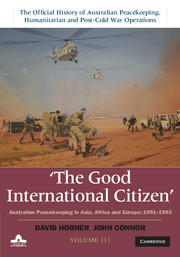Book contents
- Frontmatter
- Contents
- Maps
- Preface
- Chronology 1989–99
- Abbreviations
- Part 1 Strategy and policy
- Part 2 Cambodia
- Part 3 Western Sahara
- 12 A good international citizen
- 13 Backbone of the mission
- Part 4 Former Yugoslavia
- Part 5 Watch on Iraq
- Appendix A United Nations Security Council resolutions
- Appendix B Major office bearers, 1991–99
- Bibliography
- Index
- Plate section
- References
13 - Backbone of the mission
The Australians in Western Sahara, 1991–94
from Part 3 - Western Sahara
Published online by Cambridge University Press: 12 May 2022
- Frontmatter
- Contents
- Maps
- Preface
- Chronology 1989–99
- Abbreviations
- Part 1 Strategy and policy
- Part 2 Cambodia
- Part 3 Western Sahara
- 12 A good international citizen
- 13 Backbone of the mission
- Part 4 Former Yugoslavia
- Part 5 Watch on Iraq
- Appendix A United Nations Security Council resolutions
- Appendix B Major office bearers, 1991–99
- Bibliography
- Index
- Plate section
- References
Summary
The Western Sahara desert is a harsh, bleak yet at times beautiful landscape; except when the temperature soars to 60 degrees centigrade and the hot wind – the Sirocco – blasts across the territory, whipping up dust and sandstorms, reducing visibility to a few metres, and causing all manner of respiratory problems. The Australian signallers at the UN observer team sites had plenty of opportunity to admire the terrain. They became familiar with the rock-hard plateaus, where they could drive their vehicles at 100 kph or, less commonly, the shifting sand dunes, where vehicles could barely move. They marvelled at the high, flat-top hills and the dry riverbeds (wadis). Occasionally they spotted camels and goats; but generally it is a lifeless area, with little vegetation and no surface water.
For the UN military observers (Unmos) and their signallers, the dominating feature was the remarkable defensive berm or wall that snaked southwards across the desert from Morocco, parallel to the Algerian and Mauritanian borders, almost to the sea at its southern extremity. The Unmos had the task of supervising the ceasefire along the berm. A later observer – the commander of the British contingent at the time – described the berm as ‘a fascinating military achievement which never fails to impress’:
It is, at one and the same time, a grandiose strategic concept, a tactical stroke of genius, an engineering and organisational triumph and a demographic divide. While varying in its military effectiveness along its some 2000[km] length, being stronger in the more strategically important northern sectors, it has won the war. Polisario have publicly admitted that they have no real conventional military options. They can hurt the Moroccans and achieve a brief tactical success but only at tremendous subsequent cost.
On the Moroccan side there were two sector headquarters – at Smara and Awsard – with a further sector headquarters later being established at Oum Dreyga. Including the sector headquarters (which doubled as team sites) there were ten team sites, six on the Polisario side of the berm and four on the Moroccan side (see map 10). There was also the liaison office with the Polisario headquarters at Tindouf in Algeria.
- Type
- Chapter
- Information
- The Good International CitizenAustralian Peacekeeping in Asia, Africa and Europe 1991–1993, pp. 294 - 330Publisher: Cambridge University PressPrint publication year: 2014

